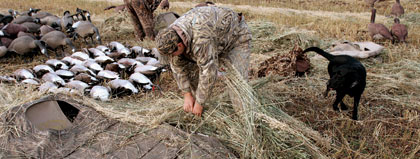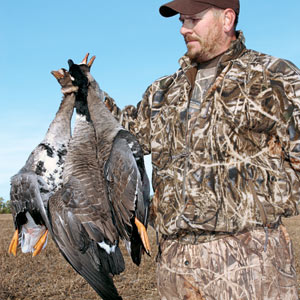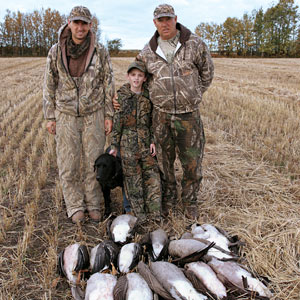November 03, 2010
By Jay Strangis
There's nothing like hunting big, happy birds.
By Jay Strangis
I guess it's inevitable, travel being what it is, that today no good place is quite safe from the masses. But somehow, once you've discovered something, some faraway, wonderful wonderland, you don't want anyone else to discover it. Take Montana, for example. I attended the University there more than 30 years ago and no one wanted to visit the place. Today, you'd think the foothills and river valleys were made of gold, and places where we hunted winter mallards all have housing developments with quaint names and security gates. It's hard to look at the changes, and it's oh so true that the world has gotten smaller...
I'm flying to Alberta and I'll be in camp in less than a day. The plane has its share of hunters from the Lower 48, a few more than I've seen before, and mine isn't the only dog in the cargo hold. I'd like to think this is our place, Buddy's and mine, but the truth is, we're just more of the rank and file that have found that to experience hunting as it once might have been, with unaffected birds, good access to fields and a pace that doesn't make every missed opportunity feel like the end of the world, you sometimes have to travel far; quite far. Yes, we're all the same, these waterfowlers and me, except some of them have come even farther than I have.
Advertisement
I meet the group I'm joining when I arrive at camp; a father and grown son, hardcore fowlers from Utah, who have brought the eight-year-old grandson to watch, and another hunter from Hawaii who has more experience with upland than waterfowl and is vibrating to get a chance at famed Alberta dark geese.
Weather Or Not
Weather in the low 40s greets us the first day in camp, an afternoon high, and there will be frost in the morning, but this is about the coolest it's been up in High Prairie, an appropriate name in my estimation, considering that I do most of my hunting on prairies a thousand miles to the southeast. This is about as high as the prairies go, where the last vestiges of agriculture meet the vast bush, the boreal forest stretching north to the tundra.
Advertisement
We're hoping for a changeover, a spat of icy temps that pushes in new birds, but our first day will be our coldest, and not nearly cold enough to usher birds out of the north. Before we've even left the warmth of the kitchen, Clint the guide warns us that concealment will be critical in the field because the geese are "worn out." I ponder this, wondering if Clint's "worn out" is the same as our "worn out" farther south.
Once we arrive at the field entrance we see that the generous farmer has left us some swaths of vines for cover, just another testament to good landowner relations. We've set just over a hundred full bodied geese in a v-shaped pattern and all the blinds have been "grassed" up when Clint gives us the standard pre-dawn, first-day instructions: Shoot your side; don't shoot over your compadres; keep your faces covered by the top flap of the blind. "You don't have to put that door flap up so high that it covers your eyes," Clint offers. "Watching the birds work is the fun you came here for." Truer words were never spoken. We definitely came for the show.
Brad, from Hawaii is the only hunter who hasn't experienced a layout blind. And when Clint's speech is done Brad turns to me on his right and asks if we will sit up to shoot. I affirm, and Brad confesses that he thought there might be some chance we'd be expected to shoot while laying down. It's starting to get light now, and I advise that he might want to practice throwing the flap over and sitting up and shouldering his gun, at least a few times. He's cradling an over/under that's probably his best chukar gun.
We're five across, with the young boy in a blind in the middle as an observer, Clint stationed just behind him. I'm on the far right, with Buddy's dog hut staked down off my left shoulder, back just far enough that I can turn my head and look him in the eye as he watches for birds. Buddy's ready for business as soon as he crawls in the hut, and I've decided not to shoot for the first part of the morning so that I can work with him. Big flocks and multiple guns require a bit of steadying practice, and besides, the season's just begun. With any luck there will be lots of birds to shoot before the fall is out.
The rest of the morning is somewhat of a blur. Honkers are coming in waves, with the occasional flock of specs in between. Most of the birds are sliding off to our left, well in range of the Utah boys, and Brad from Hawaii is getting the occasional opportunity. He admits later he missed a lot by not leading the birds, but by the end of the morning he finds his timing. After working with Buddy through the early flurries, I'm able to make a few geese pay for coming to my side of the spread. In two, too-quick hours, 31 geese are lying in the field, including the first of two Aleutian geese we will take on this hunt and a couple of mature speckle-bellies. On the way out, we track down number 32, who made it to the edge of a distant line of trees.
 |
Puddling Ducks
In this part of the world, "puddling ducks" refers to those that stop on the way from roost to field to get a drink of water. These birds are the afternoon targets of outfitters who know their secret stopping places and want to complete a daily duck limit for their clients. Our outfitter, Mike Blanchett, of Alberta Waterfowl Hunts, said we probably wouldn't see ducks in the field with the geese, and he was right. So on the first afternoon we sit on the backwater of a small creek, waiting for the birds. But these aren't the typical fresh birds I'd seen on previous trips. The birds are spread out and in hiding after early-season pressure in the fields.
So our afternoon turns into a comfortable sit on the bank, shooting the bull and waiting for the occasional flock or single. We manage 15 mallards with, from time to time, nifty shooting on nervous birds that won't finish. On the next afternoon, our tally is nine pintails off a small river with sandbars. We'd probably have done better that second afternoon had the ducks actually puddled for us, but they headed to a nearby field set without puddling. Most of the few birds we saw we're fleeing a barrage of field fire and not interested in decoying. Still, it was a beautiful afternoon with the occasional good shooting display.
Two days from now we would see just how skittish these ducks had become, when we watched them exiting our goose field before legal shooting time in waves. They'd been in and out of the field and were headed toward their safe hidey-holes before any of the shooting started. I've been to Alberta and seen what "fresh" ducks look and act like in the past when they've landed in the field sets, walking around a
nd reluctant to leave, and these were nothing like those birds.
Being that I'm someone who puts ducks before geese, I was somewhat disappointed with the duck action, but I've also hunted long enough to know that hunting waterfowl is definitely weather dependent. When the same old birds get enough hunting pressure, even in the best places in Canada, hunting gets tougher.
 Guide Clint Wirz with a pair of specs and an Aleutian. |
More Geese
Day two finds us in a tight little oats field that Mike had been saving as a ringer, last-day hunt, but the landowner had had enough of the geese raiding his swaths of grain and told Mike it was use it or lose it, because he had to get those geese out of there. You've got to love that kind of talk, and we are more than happy to oblige the suffering farmer.
We hunt another v-shaped spread with the same full-body decoys and I think I hear somebody say 15 minutes to shooting time, so I wait to load my gun. This time my black dog and I are on the left of the group. Minutes later a good-sized flock of specks makes a mad rush for the field, coming straight in on the deck. I don't think we are shooting yet, but I see I am very wrong when Clint, who has his own watch, yells, "Kill those geese." All I can do is watch helplessly and send Buddy, but I'm not the only one surprised by Clint's call. Only two of the noisy specks fall.
Not to worry, the birds come and come, mostly big, happy honkers, which makes sense given the tight quarters of this hidden gem of a little field. Big honkers like to hide. We are set up only 50 yards from a brushy fence line in these picnic grounds and we have oodles of oat cuttings for cover.
Flocks are steady, and about every third flock makes its way to our spread. On this morning they again chose to come in directly to the side opposite my blind, but after shooting what is probably their limit, the Utah boys seem to hold off for Brad and I and we center a good number of birds with handy doubles. In just 55 minutes it is over, too soon for me but just right for Clint the guide, and a collection of big grey wide-bodies are gathered up for pictures.
Full Moon Rising
As the days of our trip wane, the moon waxes, and by the last morning, in the pre-dawn darkness, we are looking at a full moon as we set the full-bodied goose decoys in a large barley field. The field still holds swaths of the rich grain waiting for the combine and a steady overnight wind makes blind and decoy positioning easy decisions. We set in a hook-style spread, one side short, one side long, and crawl out of the wind and into our cozy blinds as the sky begins to glow. As we wait, those clouds of ducks I mentioned earlier can be made out leaving the far end of the field following the distant tree line.
Is the full moon directing this nocturnal duck behavior, or hunting pressure, or both? We toss this about as we watch for the first goose flights of the morning. This field was said to hold a good number of Canadas, but the first flights are specs with an agenda that doesn't include us. They beat their way from their roosts somewhere beyond our boot toes, crossing toward us and to one side in their noisy, swerving speck way, leaving our field to head to some field farther upwind. A couple of small, nervous flocks of specks make half-hearted passes at the decoys, and we tally some fairly long shots to bring down a few young birds, but by the time the sun tops the horizon, it becomes clear that this plan is not working as hundreds of birds beat their way upwind across our field without giving us a serious look.
 |
When we sail a long bird far to our left, Greg, the patriarch of the Utah boys decides to take a hike to look for it, and perhaps try some pass shooting on the wood line. Seeing how futile things are fast becoming, I soon follow him. We try to find some lanes by which the geese are crossing the field as points of ambush. I am shooting steel BBs in a modified choke, and haven't brought my choke tubes into the field. Greg has a custom extended-range choke in his gun and puts on a clinic for long-range shooting, knocking down at least one bird out of most of the flocks that come within his effective range. By the time the morning had ended, we've tallied 13 geese, including one of a trio of foolish, decoying young specks that Greg's son Thad scratches out of the sky with a memorable hunt-closing long shot.
The look on Hawaii Brad's face says it all as we pack up the rig on that windy, final morning, knowing that in just a few hours we'll all be on our way toward home. He's bubbly and as energetic as a pup on his first outing, and the fact that by Alberta standards the geese have won on this morning, does nothing to dampen his mood. And moods can be contagious. We're going back to a big breakfast after a heck of a two-and-a-half day hunt. Everybody's satisfied.
When I run into Mike Blanchettt, just back from scouting, at camp he offers apologies for the Canada goose field that turned out to be a speck field on this final morning. "They were there," Mike says. "Last night I saw them myself. They just traded for another field for some reason."
I understand that. It happens. These are wild birds. Anytime we go on the road at home for three days of hunting, two out of three wins is considered a home run. I also understand that outfitters have higher expectations for their clients' success, but there's no one complaining in this group. We came to hunt, and we got three happy days of it, with plenty of birds to go around.
And that's the thing about Alberta: Despite it's seeming popularity, there's still plenty of good hunting to go around.

